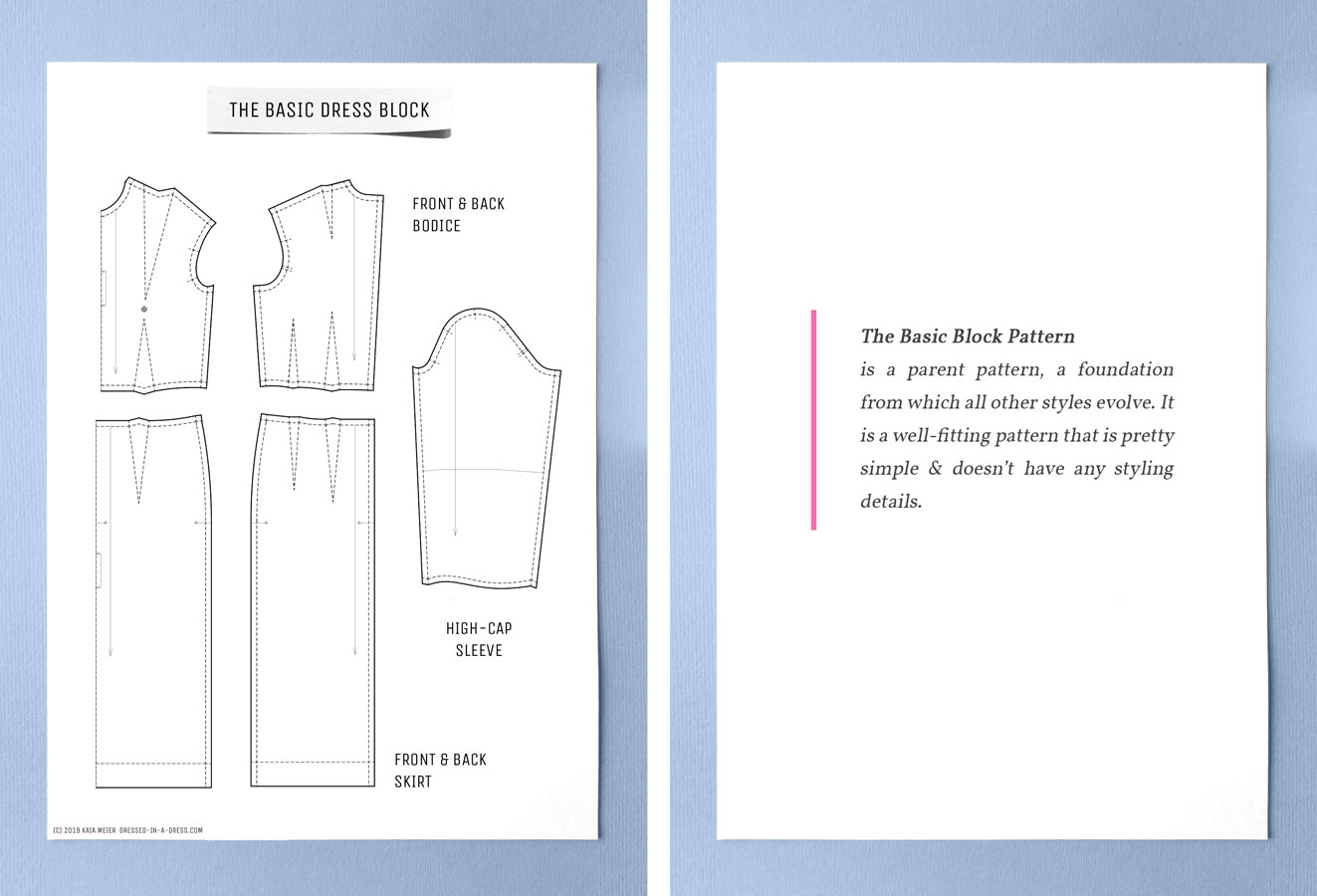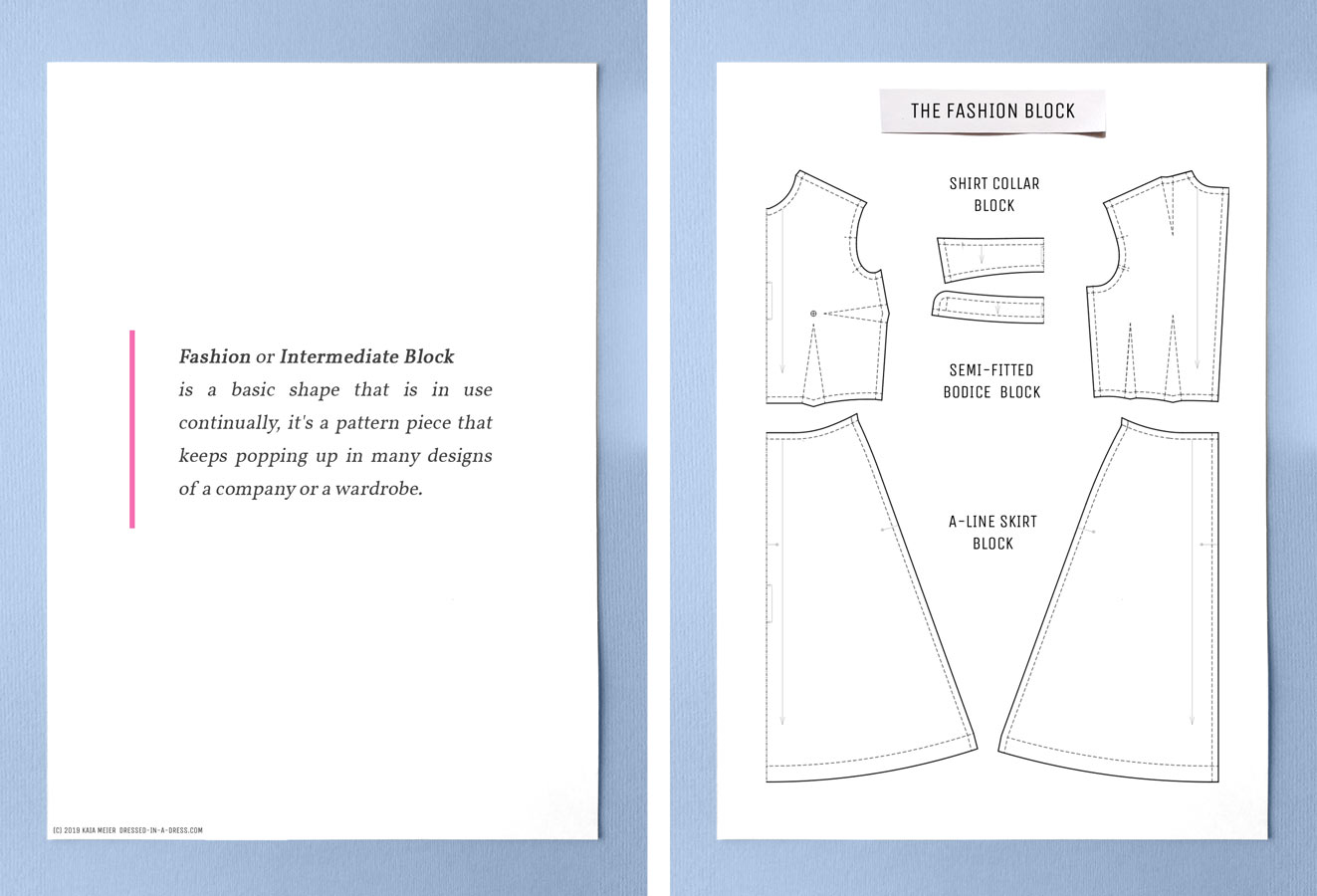01. The Block Patterns
Category: Patternmaking Series 22 January 20
In the previous introduction post, I briefly wrote about two main stages of patternmaking that lead you from an idea to a beautiful dress: the basic block and flat patternmaking. Let’s find out what the first one is.
Block patterns are the basic shapes which are later transformed into new garment designs.
You might find them not only in the apparel field but in bag, shoes and many other fields, which I know nothing about. So let’s get back to clothing.
The block pattern section might be divided into two categories: the basic block and the fashion block.
The Basic Block
The basic block pattern is a parent pattern, a foundation from which all other styles evolve. It is a well-fitting pattern that is pretty simple and doesn’t have any styling details. Usually, it has seam allowances, but some articles and books tell the opposite.

The basic block uses measurements of a company’s fit model if speaking about the industry, or your body measurements if you make patterns for yourself. Apart from the measurements, the basic block contains a certain amount of ease.
Ease is the centimetres added to the body measurements to make it possible and convenient for us to walk, breathe, raise our hands, eat—that is wearing ease—or a specific silhouette—that is design ease.
Types of Basic Blocks
Most of the time, the basic block has the minimal sufficient wearing ease. But it is helpful if you have basic blocks for different silhouettes. The most common ones are:
Loose—for designs with a relaxed fit;
Semi-fitted—like in a sheath dress;
Fitted—for sleeveless designs or fabrics that stretch.
I skip the last one and transform the semi-fitted one into it usually.
Also, the basic blocks don’t only differ in silhouettes—there are separate ones for different types of clothing:
- Dresses, blouses and skirts —in some systems they may share the same basic block, of which I’m not a fan.
- Pants
- Jackets
- Coats, etc.
And I almost forgot to mention that there are different blocks for different fabrics: woven or knitted.
Where to get one
That sounds like a lot of work, but you don’t need all of them right now. And you don’t have to draft the basic block if you are not fond of math or drafting. There always are options:
- Order a basic block from a pattern maker. So you can be sure it is created according to your measurements and body type.
- Adapt the commercial sewing pattern. Some platforms or stores sell basic patterns without excess design detailing, some don’t. In the first case, you’ll need to find the one that matches your measurements in the best way. In the second—compare the measurements and try to find the pattern close to the sheath dress.
- Use online resources that create basic patterns according to your measurements and the amount of ease desired.
- It is my favourite: draft your pattern yourself. Take some time to master a pattern-making course or study the manual—whatever works best for you will be great. Learn how to fly to feel free. Not literally, of course.
Once you have your basic block, you don’t need to redraft it from beginning every time as long as your measurements remain the same.
So, the more accurate the measurements and the fit of the basic block are, the better the future garments will fit and the less fitting alterations you’ll have.
My suggestion is to spend some time to make a cheap fabric toile of a basic block to check the proportions and shape and get rid of all fitting issues right at the start so that they won’t bother you later. And then, when your perfectly fitting basic block is ready, you can start manipulating it like a pro so that you will have those gorgeous silk or woollen or lace dresses.
As I said before, the more patterns you make, the less time you will spend on the next designs.
And that’s because even pattern makers, well, especially, pattern makers do not draft from scratch or even basic block every season. Over time they create a library of pattern blocks—imagine them as puzzle pieces—that can be mixed with minimal alterations for various styles.
Let’s call those pieces—fashion blocks.
The Fashion Block
Fashion or intermediate block is a basic shape that is in use continually; it’s a pattern piece that keeps popping up in many designs of a company or a wardrobe.
For example, I love semi-fitted dresses with an A-line skirt, I’ve recently realized that I need shirt-dresses and kimonos in my closet. So, my fashion blocks are a semi-fitted bodice, an A-line skirt, a shirt collar with a stand and, of course, kimono which I use for silk T-shirts, dresses and dusters.
Every brand or every sewist will have a unique collection of fashion blocks. I hope you also will have one soon; I can help you with it.

That’s all for today. In the next post, we’ll be talking about Pattern Shapes & Flat Patternmaking. Let me know if you need some information on patternmaking books or online services.
xoxo,
Kaia
